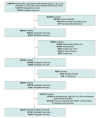Initiation of Pregabalin vs Gabapentin and Development of Heart Failure
- PMID: 40748640
- PMCID: PMC12317353
- DOI: 10.1001/jamanetworkopen.2025.24451
Initiation of Pregabalin vs Gabapentin and Development of Heart Failure
Abstract
Importance: Both pregabalin and gabapentin are common nonopioid medications used to treat chronic pain, which affects up to 30% of patients. Because pregabalin has greater potency than gabapentin in binding to the α2δ subunit of the L-type calcium channel, pregabalin may be associated with an increased risk for heart failure (HF).
Objective: To compare incident hospitalizations and emergency department (ED) visits for HF among new users of pregabalin vs gabapentin among Medicare beneficiaries with noncancer chronic pain.
Design, setting, and participants: This retrospective cohort study included data collected between January 1, 2015, and December 21, 2018, for Medicare beneficiaries aged 65 to 89 years with chronic noncancer pain and without a history of HF and terminal illnesses. Data were analyzed from March 21 to December 2, 2024.
Exposure: New use of pregabalin or gabapentin.
Main outcomes and measures: The primary outcome was hospital admission or ED visit with a primary discharge diagnosis of HF. Secondary outcomes were incidence of outpatient HF diagnosis and all-cause mortality. Adjusted hazard ratios (AHRs) were calculated using inverse probability of treatment weighting propensity score adjustment accounting for 231 covariates, including demographic, clinical, and health care utilization variables and medication use.
Results: The cohort included 246 237 Medicare beneficiaries, of whom 18 622 (7.6%) were new users of pregabalin and 227 615 (92.4%) were new users of gabapentin; the cohort was predominantly female (66.8%), with a median age of 73 years (IQR, 69-78 years). During 114 113 person-years of follow-up, 1470 patients had a hospital admission or ED visit for HF. The rate of HF was 18.2 (95% CI, 15.3-21.6) per 1000 person-years for pregabalin and 12.5 (95% CI, 11.9-13.2) per 1000 person-years for gabapentin (AHR, 1.48 [95% CI, 1.19-1.77]). When restricted to patients with a history of cardiovascular disease, pregabalin was associated with an elevated HF risk compared with gabapentin (AHR, 1.85 [95% CI, 1.38-2.47]). Increased risk of outpatient HF incidence was also noted among patients receiving pregabalin compared with those receiving gabapentin (AHR, 1.27 [95% CI, 1.02-1.58]). All-cause mortality was not significantly different between groups (AHR, 1.26 [95% CI, 0.95-1.76]).
Conclusions and relevance: In this retrospective cohort study of Medicare beneficiaries with chronic noncancer pain, incident HF was increased in new users of pregabalin compared with new users of gabapentin. These findings should be considered, especially in patients with a history of cardiovascular disease.
Conflict of interest statement
Figures
Comment in
References
Publication types
MeSH terms
Substances
Grants and funding
LinkOut - more resources
Full Text Sources
Medical
Research Materials
Miscellaneous


